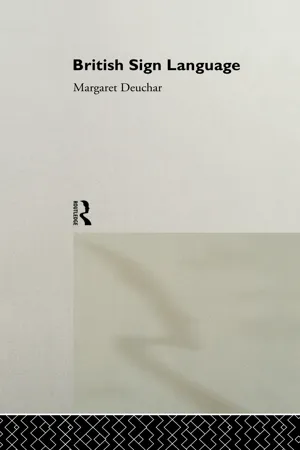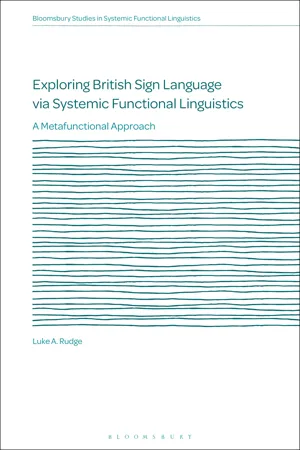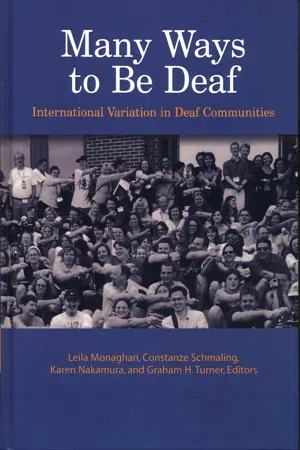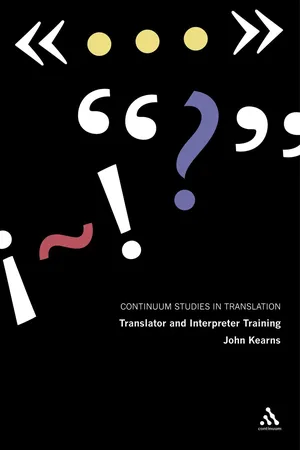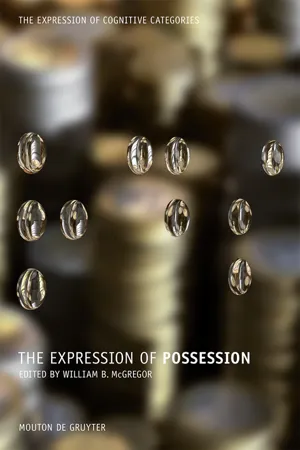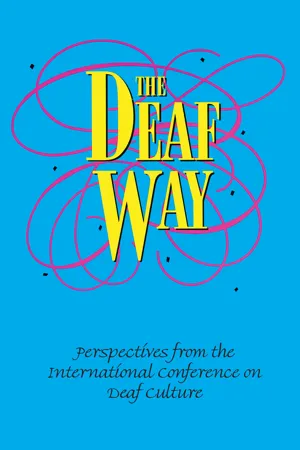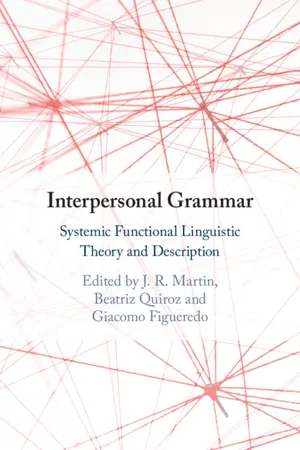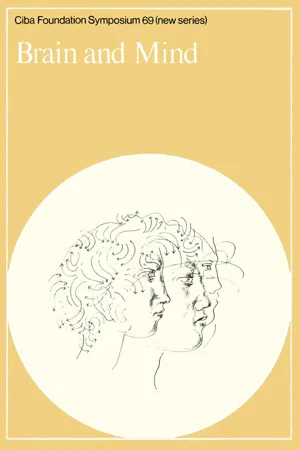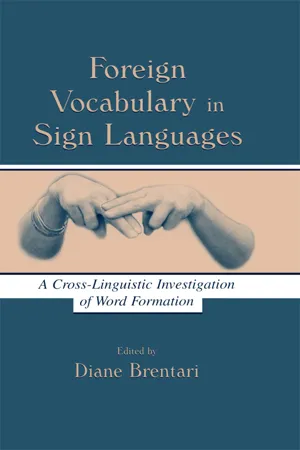Languages & Linguistics
British Sign Language
British Sign Language (BSL) is a visual-gestural language used by Deaf and hard of hearing communities in the United Kingdom. It has its own grammar and syntax and is not simply a visual representation of spoken English. BSL is an important means of communication and cultural expression for the Deaf community in the UK.
Written by Perlego with AI-assistance
Related key terms
1 of 5
11 Key excerpts on "British Sign Language"
- eBook - ePub
- Margaret Deuchar(Author)
- 2013(Publication Date)
- Routledge(Publisher)
1What is BSL?
This chapter is intended as an introduction to British Sign Language (BSL) for those who have little previous experience of it. I shall attempt to answer the general question posed by the title of this chapter by trying to answer a series of questions of the kind typically asked by hearing people coming across sign language for the first time.Let us start, however, with a rough definition of the term ‘BSL’ as it is used in this book. ‘BSL’ refers to a visual-gestural language used by many deaf people in Britain as their native language. The term ‘visual-gestural’ refers to both the perception and production of BSL: it is produced in a medium perceived visually, using gestures of the hands and the rest of the body including the face. Although the term ‘manual’ is sometimes used to describe BSL, I have avoided it here because of the implication that only the hands are involved. As we shall see, it is true that most research has concentrated on what the hands do, but recently we have become more aware of the important role played by body stance, head movement and facial expression.BSL is used by many deaf people: we do not know exactly how many, though an estimate of 40,000 has been made, based on a survey in the early 1970s, of the number of deaf people attending clubs or known to social workers (Sutcliffe, personal communication). These people are mostly born deaf, to either deaf or hearing parents (but also hearing people born to deaf parents), and learn BSL either from their parents (if deaf), deaf siblings, or deaf peers. I have described BSL as these people's ‘native language’ because it is the language they know best and are most comfortable with. It may not necessarily be the first language they are exposed to, however. The particular way in which BSL is acquired will be discussed in chapter 7 - eBook - ePub
Exploring British Sign Language via Systemic Functional Linguistics
A Metafunctional Approach
- Luke A. Rudge(Author)
- 2022(Publication Date)
- Bloomsbury Academic(Publisher)
1 Introducing British Sign Language: A Sociocultural and Linguistic OverviewLanguages and their sociocultural contexts of use are tightly intertwined. Influence is constantly exerted between them, alongside external influences, such that the use of a language entails playing a part in its associated culture(s) in some way. In a similar vein, to understand a language, there must be an understanding of its cultural context and place in the world.Before diving into any deep linguistic description, it is necessary to begin with an introduction to British Sign Language (BSL) from a sociocultural perspective. I aim to provide the reader with a deeper awareness with regard to the language, its users, the cultural labels that are used and the development of BSL, ranging from several centuries ago through to contemporary events and legislation enacted within the UK. The focus then shifts towards broad linguistic aspects of BSL, presenting an overview of some of the core elements of BSL production. This linguistic summary acts as a primer to the following chapters, wherein BSL is observed, described and analysed through the lens of Systemic Functional Linguistics (SFL).If readers are neither BSL users nor users of another sign language, the second half of this chapter offers a useful base from which further linguistic discussion can grow, and as a point of reference for terms and concepts that are revisited throughout later chapters. It must be noted that what is offered in this chapter is by no means a complete introduction to BSL and that the most appropriate way to become engaged with BSL (or any sign language) is to attend registered, deaf-led classes. Nonetheless, this initial introduction suffices as an introductory exploration of the language, and concepts that may require further clarification will be elaborated on where required. - eBook - PDF
Many Ways to Be Deaf
International Variation in Deaf Communities
- Leila Monaghan, Constanze Schmaling, Karen Nakamura, Graham H. Turner, Leila Monaghan, Constanze Schmaling, Karen Nakamura, Graham H. Turner(Authors)
- 2014(Publication Date)
- Gallaudet University Press(Publisher)
BSL is a visual gestural language, completely independent of the English lan-guage (Brennan 1992; Sutton-Spence and Woll 1999). The grammar and vocabu-lary of BSL bear no relation to English. “Signed English,” in which the signs of BSL follow English grammar with additional markers to represent English mor-phology (McCracken and Sutherland 1992), is not the natural language of the 25 26 Rachel Sutton-Spence Deaf community but has been a tool of educators of the deaf to teach English to deaf children. Although BSL is independent of English and is not a creation of hearing people, the manual alphabet today is used by signers to reproduce En-glish words as part of BSL. Manual alphabets are used in many countries in com-munication among members of the Deaf community and between deaf and hearing people (Carmel 1981). The two-handed British manual alphabet consists of 26 basic hand arrange-ments that correspond to the 26 letters of the English alphabet. Each hand ar-rangement is a manual letter. Another manual alphabet also is used by some members of the British Deaf community, the one-handed Irish manual alphabet, used by some Roman Catholic signers, especially in Glasgow, London, and north-west England. That manual alphabet will not be considered further here. Finger-spelling is produced when the manual alphabet is used to reproduce the spelling of English words. The British manual alphabet is shown in figure 2.1. All British signers are bilingual to some extent. A signer may use English through any combination of speech and lipreading, reading and writing, or the production and reception of fingerspelling. Throughout history, many deaf peo-ple have learned English through formal education, especially in schools (see Evans 1978). Fingerspelling has played an important but varying role in the edu-cation of Britain’s Deaf community. The use of the manual alphabet in deaf educa-tion also has influenced BSL because fingerspelled words have become a part of F IGURE 2.1. - No longer available |Learn more
- (Author)
- 2014(Publication Date)
- Learning Press(Publisher)
BSL is used in some educational establishments, but is not always the policy for deaf children in some local authority areas. The Let's Sign BSL and fingerspelling graphics are being developed for use in education by deaf educators and tutors and include many of the regional signs referred to above. Learning British Sign Language British Sign Language can be learnt throughout the UK and three examination systems exist. Courses are provided by community colleges, local centres for deaf people and private organisations. Most tutors are native users of sign language and hold a relevant teaching qualification. Signature excellence in communication with deaf people is accredited by the Quali-fications and Curriculum Authority (QCA) and provides awards at the following levels: • Level I – Elementary • Level II – Intermediate • Level III/ NVQ 3 – Advanced • NVQ 4 – Required as part of the NVQ 4 BSL/English Interpreting The British Deaf Association has formed the BSL Academy to provide an official British Sign Language curriculum and tutor training. In Scotland, there is a Scottish Qualifications Authority (SQA) system for students learning British Sign Language. Currently there are 3 levels in the SQA system (continuing assessments): • SQA: Introduction to British Sign Language • SQA: British Sign Language Level 1 • SQA: British Sign Language Level 2 ________________________ WORLD TECHNOLOGIES ________________________ Saying thank you in BSL. Flat hand in front of the chin and sweep outwards/forwards Becoming a BSL / English interpreter Deaf Studies courses with specific streams for sign language interpreting exist at several British universities. Course entry requirements vary from no previous knowledge of BSL to NVQ level 4 BSL (or equivalent). - eBook - PDF
- Alan Davies, Catherine Elder, Alan Davies, Catherine Elder(Authors)
- 2008(Publication Date)
- Wiley-Blackwell(Publisher)
British Sign Language 179 experiences of life within British society. The British deaf community shares life experiences and culture, but these are embedded within the hearing world. When hearing people do not appreciate deaf values and the importance of certain behaviors, friction and even hostility can occur. Perhaps the area where such conflict is greatest is in the area of language. Young, Ackerman, & Kyle (1998) studied the use of sign language in the workplace (in psychiatric units for deaf people and in a school for deaf children), exploring the role of signers as not only service users but also as service providers. The signing skills of deaf staff were far superior to those of their hearing colleagues. These skills were especially important for communicating with mentally ill deaf people or with deaf children. Despite this, the deaf staff had lower-grade jobs than the hearing staff, although the delivery of services depended on deaf staff and their cultural and linguistic skills. They thus had low status, but high value. Since only a BSL linguistic environment provided deaf staff with full access to information at work, hearing staff were required to use BSL at all times when a deaf person was present or might be present. Deaf and hearing people differed in the way they viewed this policy. For deaf staff, signing promoted involvement, making deaf people feel confident, valued, and respected, and with a sense of well-being; signing promoted the development of personal and social relationships between deaf and hearing people; signing enabled deaf staff to fulfill their professional roles and responsibilities. In contrast, for hearing staff, signing caused lack of confidence, and worries about linguistic competence; hearing people felt that the pressure to sign was sometimes too great. When they were tired, distracted, or under pressure, they reverted to English. - eBook - PDF
Translator and Interpreter Training
Issues, Methods and Debates
- John Kearns(Author)
- 2008(Publication Date)
- Continuum(Publisher)
Ultimately this proved not to be the case; on the contrary, reviewers were very open in the research setting and shared information with her, which as a native - but female -BSL user she had never before been party to. Moreover, two other female members of the research team were also present in the room - an interpreter taking notes and another team member filming. The research team felt very privileged that grassroots members of the BSL community were willing to share deep layers of informa-tion about their language in very open and frank discussion. This highlighted the value of establishing mutual respect and trust in the research context and demonstrated that informants would be flexible about normal boundaries 145 Translator and Interpreter Training (e.g. using language in a way which is usually culturally unacceptable), if the environment were right. The BSL search tool British Sign Language is a visual-gestural language which evolves in time and space, in three dimensions (horizontally, vertically and in-depth, that is, along the line from a position in front of the signer to one behind him/her). As noted earlier, an individual sign is a composite of a number of different elements -handshape, location in the signing space, type of movement and orientation -which may be combined with facial expression and mouth pattern. The SLIP team were determined from the start that the BSL dictionaries should be self-sufficient and that it was not acceptable to use English to search for a sign entry. As there is no written form of BSL, it has already been outlined how the majority of dictionaries rely on English as a means of searching for a BSL term. This is misleading as regards the relationship between English and BSL and could potentially restrict access to the BSL terms depending on the user's competence in English. - eBook - PDF
- William B. McGregor(Author)
- 2010(Publication Date)
- De Gruyter Mouton(Publisher)
Possession in the visual-gestural modality: How possession is expressed in British Sign Language Kearsy Cormier and Jordan Fenlon 1. Introduction All known languages have some way of expressing possession, and signed languages are no exception. The primary question we pose in this chapter is: Is possession expressed differently in signed languages due to the use of the visual-gestural (rather than the aural-oral) modality, or are patterns re-lating to possession essentially the same for signed and spoken languages? Our chapter begins with background about British Sign Language (BSL), followed by an overview of the pronominal system of BSL. We then move on to look at attributive and predicative possession in BSL and finally an adjectival predicate of predisposition in BSL closely related to the posses-sive pronoun. Although this chapter is primarily an overview of possession in BSL, we will also include observations on other signed languages, such as American Sign Language (ASL), where applicable. 2. British Sign Language BSL is the natural signed language used by the deaf community in the United Kingdom. BSL has its own phonological, morphological and syn-tactic structure. Phonologically, lexical signs in BSL are made up of four primary parameters: handshape, movement, location (i.e. place of articula-tion) and palm/finger orientation. Every sign is specified for each of these parameters, which are phonologically contrastive (i.e. minimal pairs can be identified with each parameter). Clearly, BSL is neither simply an elaborated gestural system nor a manual code based on English. Nonetheless, because BSL is a minority language within the United Kingdom, there is strong and constant contact between BSL and English and thus BSL does borrow elements from English. Having said that, we will point out instances where there are possessive construc-tions within signed languages which are known borrowings from the sur-rounding spoken language. - eBook - PDF
The Deaf Way
Perspectives from the International Conference on Deaf Culture
- Carol J. Erting, Robert C. Johnson, Dorothy L. Smith, Bruce C. Snider, Carol J. Erting, Robert C. Johnson, Dorothy L. Smith, Bruce C. Snider(Authors)
- 2009(Publication Date)
- Gallaudet University Press(Publisher)
Things began to change dramatically in the late 1970s when British Sign Language (BSL) research projects were established in centers of higher education, most notably at Moray House College in Edinburgh and at Bristol University. It was not until the 1980s, however, that significant numbers of Deaf people really became involved in teaching sign classes. Training courses were established in London, in Glasgow, at Bristol Univer- sity, and, since 1985, at Durham University. Not all the courses that were established, however, provided training in BSL. During the 1987-1988 broadcast season, a weekly television series entitled "British Sign Language for Beginners" was broadcast. As a consequence, the demand by hear- ing people for sign language classes increased. The very limited number of Deaf tutors offering BSL classes were totally unable to meet the demand. The Durham University British Sign Language Tutor Training Course was estab- lished to address the shortage of trained Deaf BSL tutors, as described in Clark Den- mark's paper. The project was sponsored by the British Deaf Association, the national representative organization of adult Deaf people in Britain. The course was taught in BSL. Deaf people did not have to be fluent in English to apply or to be offered a place in the course. The main selection criterion was the Deaf applicant's competence in BSL and potential to become a BSL tutor, for which fluency in English is not a prerequisite. Course Principles At Durham, we use a structured functional notational syllabus developed by Vista Col- lege, Berkeley, California, adapted to the Deaf culture of Britain and translated into BSL. Teaching Across Modalities The introductory syllabus is based on the first ten units (Foundation Level) of the Vista syllabus (Smith, Lentz, and Mikos, 1988). The first five units are given to the tutors dur- ing their training course; the other five, after they have successfully completed it. - eBook - PDF
Interpersonal Grammar
Systemic Functional Linguistic Theory and Description
- J. R. Martin, Beatriz Quiroz, Giacomo Figueredo(Authors)
- 2021(Publication Date)
- Cambridge University Press(Publisher)
& Cormier, K. (2018). Variation and Change in Varieties of British Sign Language in England. In N. Braber and S. Jansen, eds., Sociolinguistics in England. London: Palgrave Macmillan, pp. 165–88. Stamp, R., Schembri, A., Fenlon, J., Rentelis, R., Woll, B. & Cormier, K. (2014). Lexical Variation and Change in British Sign Language. PLoS ONE, 9(4), 811–24. Sutton-Spence, R. & Woll, B. (1999). The Linguistics of British Sign Language: An introduction. Cambridge: Cambridge University Press. Systemic Functional Glossing Conventions. (2018). Retrieved from: https://systemiclangua gemodelling.files.wordpress.com/2018/09/systemic-functional-glossing-conventions- version-september-2018.pdf (last accessed 10 November 2020). Taverniers, M. (2018). Grammatical Metaphor and Grammaticalization: The Case of Metaphors of Modality. Functions of Language, 25(1), 164–204. Teruya, K., Akerejola, E., Andersen, T. H., Caffarel, A., Lavid, J., Matthiessen, C. M. I. M., Petersen, U. H., Patpong, P. & Smedgaard, F. (2007). Typology of mood: A Text-Based and System-Based Functional View. In R. Hasan, C. M. I. M. Matthiessen and J. J. Webster, eds., Continuing Discourse on Language: A Functional Perspective, vol. 2. London: Equinox, pp. 859–920. Van der Kooij, E. & Crasborn, O. (2016). Phonology. In A. Baker, B. van den Bogaerde, R. Pfau and T. Schermer, eds., The Linguistics of Sign Languages: An Introduction. Amsterdam: John Benjamins, 251–78. Ventola, E. (1987). The Structure of Social Interaction: A Systemic Approach to the Semiotics of Service Encounters. London: Pinter. Wakeland, E., Austen, S. & Rose, J. (2018). What is the Prevalence of Abuse in the Deaf/Hard of Hearing Population? The Journal of Forensic Psychiatry and Psychology , 29(3), 434–54. Woodward, J. C. (1975). How You Gonna Get to Heaven if You Can’ t Talk with Jesus: The Educational Establishment vs. the Deaf Community . Paper presented at the 34th Annual Meeting of the Society for Applied Anthropology. - eBook - PDF
- G. E. W. Wolstenholme, Maeve O'Connor(Authors)
- 2009(Publication Date)
- Wiley(Publisher)
At the beginning of our research, some eight years ago, we did not know whether ASL was an independent language, nor precisely how that concept might apply to gestural communication. The available literature generally stressed the icon and image behind the global form of signs. We read that sign language is ‘a collection of vague and loosely defined pictorial gestures’; that it is a ‘universal’ communication; that it is pantomime; that it is ‘much too much a depicting language, keeping the thinking slow’; that ‘sign language deals mainly with material objects, dreads and avoids the abstract’; that it is ‘derived from English, a pidgin form of English on the hands with no structure of its own’. We were then faced with a communication system that appeared totally different from speech and spoken language, a communication system that apparently violated some of the putative universal characteristics posited for human language: that language is based on speech and the vocal apparatus; that linguistic symbols are essentially arbitrary, the form of a symbol bearing no relation to the form of its referent. What aroused our interest was the opportunity to study a language that had developed fully in an unexpected and different mode. Since that time, our investigations have covered a wide array of concerns: the linguistic structure of the sign ; iconicity in signs and signing; historical change in signs; immediate and long-term memory for signs; comparison between two independent sign languages; perception of signs; studies of slips of the hand; the role of non-manual signals in the language; studies of ASL syntactic processes; studies of the rate of production of sign language and spoken language; studies of grammatical processes such as compounding, derivational and inflectional processes; studies of invented or recently coined - eBook - ePub
Foreign Vocabulary in Sign Languages
A Cross-Linguistic Investigation of Word Formation
- Diane Brentari(Author)
- 2001(Publication Date)
- Psychology Press(Publisher)
This can be illustrated further with reference to the development of new technical terms within BSL. I focus here particularly on examples relating to sign linguistics and to sign language generally. One might expect, given the role of fingerspelling in the introduction of new technical terminology to BSL users, that the lexicalization of fingerspelled forms would be a major force in the creation of new terminology. However, what is suggested here is that although borrowings do have an important role in this process, it is the productive lexicon, used in conjunction with fingerspelling, that takes the process forward. Finger-spelling is the support required in the early stages, but it is the productive lexicon that carries the sign creation process through.If we look at the relatively new linguistic terminology, it is interesting to see how few of the terms that are now in common usage among teachers and students of BSL are actually based on English borrowings as such. Indeed there is some evidence that forms that do relate to fingerspelling are being taken over by other, what I would wish to describe as “motivated” terms. Thus the concept of linguistics is expressed in BSL by two main forms: the first is based on a relatively old sign LANGUAGE, which itself is linked to the meaning ‘written language,’ that is, the nondominant hand is a Size and Shape Specifier classifier, or a flat surface (paper), with the dominant hand indicating the lines (of writing). The form LINGUISTIC is created by performing the simple directional movement involved in the sign LANGUAGE, but adding to this the curved handshape representing -C- (in this case the full-handed form). However, the sign has been used alongside a sign making use of two -F- handshapes initially contacting then separating. This latter sign appears to be becoming the more popular of the two. It is possible that in this case it is the written connotations of the first sign that work against its continued use with reference to signed language, and even to spoken language, or linguistics. The sign GRAMMAR, using the initial -G- manual alphabet configuration and followed by the same sign LANGUAGE also appears to be used less frequently: it is often replaced by signs based on the old BSL STRUCTURE. Not surprisingly, given the newness of the field to most Deaf people, several different signs are often in use for the same concept. However, in other cases, signs have become well established. In one case the sign has been restructured toward a fingerspelled form. The sign ICONIC was used primarily by sign language researchers in the late 1970s. It had quite wide acceptance among Deaf people involved in research. In this early form, it was a motivated sign, exploiting the V-hand of the sign LOOK in front of the eye, but producing a closing action toward the eye-a form regarded by some as indicating the notion of copying or taking in a visual form. It is now popularly produced by placing the dominant index finger below the eye and then moving the hand away in a short action with the hand configuration changing to a curved-V. In discussing this with Deaf people, it seems that many internalize the sign as ‘eye + c,’ in a way that appears to match the beginning and end of the spoken form. Although both forms are still in use, the latter form seems to enjoy greater popularity.
Index pages curate the most relevant extracts from our library of academic textbooks. They’ve been created using an in-house natural language model (NLM), each adding context and meaning to key research topics.
